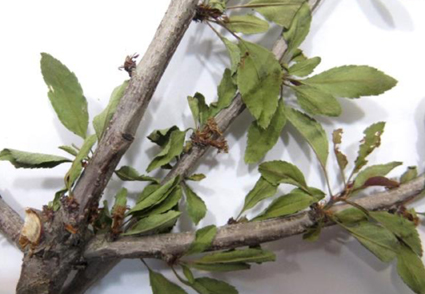Abstract
Prunus mazandaranica is described as a new species from north Iran. The new species has been placed in the sect. Microcerasus and could readily be distinguished from the closest relative, P. microcarpa subsp microcarpa, Prunus yazdiana, and Prunus paradoxa by indistinct brachyblasts, fasciculate inflorescence of 2–5 sessile or subsessile flowers with 10–12 unequal-sized stamens and glabrous style and ovary. Also, Prunus jacquemontii is recorded for the first time from northeast Iran. It is similar to P. griffithii morphologically, an endemic species distributed in Afghanistan, but distinguished from it by its glabrous leaves and glabrous style and ovary. Micromorphological features of pollen grains and leaf epidermal cells, surface are presented using Scanning Electron Microscopy. The diagnostic traits, a geographic distribution map, and detailed photos of the taxa are also presented here.
References
<p>Baranova, M.A. (1992) Principles of comparative stomatographic studies of flowering plants. <em>Botanical Reviews</em>. 58: 49–99. https://doi.org/10.1007/BF02858543</p>
<p>Barthlott, W., Neinhuis, C., Cutler, D., Ditsch, F., Meusel, I., Theisen, I. & Wilhelmi, H. (1998) Classifications and terminology of plant epicuticular waxes. <em>Botanical Journal of the Linnean Society</em> 126: 237–260. https://doi.org/10.1111/j.1095-8339.1998.tb02529.x</p>
<p>Browicz, K. (1969) <em>Cerasus</em>. <em>In:</em> Rechinger, K.H. (Ed.) <em>Flora Iranica</em>, Vol. 66. Akademische Druck-u. Verlagsanstalt, Graz. pp. 187–202.</p>
<p>Browicz, K.(1972) <em>Cerasus</em>. <em>In:</em> Davis, P.H. (Ed.) <em>Flora of Turkey and the east Aegean Islands,</em> Vol. 4. Edinburg at the Universiry Press, Edinburg. pp. 12–19.</p>
<p>Browicz, K. (1972) <em>Distribution of woody Rosaceae in W. Asia I. Cerasus microcarpa (C. A. Mey.) Boiss.</em> Vol. 13. pp. 5‒26.</p>
<p>Browicz, K., Zieliński, J. (1982) <em>Chorology of Trees and Shrubs in Southwest Asia and Adjacent Regions</em>. Volume 1. Polish Scientific Publishers.</p>
<p>Carpenter, K.J. (2005) Stomatal architecture and evolution in basal angiosperms. <em>American Journal of Botany</em> 92: 1595–1615.</p>
<p>Chaoluan, L., Shunyuan, J. & Bartholomew, B. (2003) <em>Cerasus</em>. <em>In:</em> Wu, Z.-Y., Raven, P.H. & Hong, D.Y. (Eds.) <em>Flora of China</em>, Vol. 9. Science Press, Missouri Botanical garden Press, Beijing, Saint Louis. pp. 403–420.</p>
<p>Dehshiri, M.M., Mozaffarian, V. & Ahmadi, M. (2010) <em>Cerasus paradoxa</em> (Rosaceae), a new species from Iran. <em>Irainian Journal of Botany </em>18 (2): 220–223.</p>
<p>Erdtman, G. (1952) <em>Pollen Morphology and Plant Taxonomy</em>. Almqvist & Wiksell, Stockholm.</p>
<p>Hesse, M., Halbritter, H., Zetter, R., Weber, M., Buchner, R., Frosch-Radivo, A. & Ulrich, S. (2009) <em>Pollen Terminology an Illustrated Handbook</em>. Springer Wien, New York.</p>
<p>Khatamsaz, M. (1992) <em>Cerasus</em>. <em>In:</em> Assadi, M. (Ed.) <em>Flora of Iran</em>, Vol. 6. Research Institute of Forests and Rangelands, Islamic Republic of Iran. pp. 315–332.</p>
<p>Linnaeus, C. (1753) <em>Species Plantarum</em>: 1st edn. laurentii salvii, Holmiae, Stockholm.</p>
<p>Looney, N.E. & Jackson, D.I. (1999) <em>Stone Fruit</em>. <em>In:</em> Jackson, D., Thiele, G., Looney, N. & Morley-Bunker, M. (Eds.) <em>Temperate and Subtropical Fruit Production.</em> CABI, UK. pp. 171–188.</p>
<p>Meikle, R.D. (1966) <em>Prunus</em>. <em>In:</em> Townsend, C.C. & Guest, E. (Ed.) <em>Flora of Iraq</em>, Vol. 2. Baghdad, Ministry of Agriculture and Agarian Reform, Republic of Iraq. pp. 153–171.</p>
<p>Mozaffarian, V. (2002) Studies on the flora of Iran, new species and new Records. <em>Pakistan Journal of Botany</em> 34 (4): 391–396.</p>
<p>Nuri Nas, M., Boleck, Y. & Bardak, A. (2011) Genetic diversity and phylogenetic relationships of <em>Prunus</em> <em>microcarpa</em> C.A. Mey. subsp. <em>tortuosa</em> analyzed by simple sequence repeats (SSRs). <em>Scientia Horticulturae</em> 127: 220–227. https://doi.org/10.1016/j.scienta.2010.09.018</p>
<p>Pojarkova, A.I. (1941) <em>Cerasus</em>. <em>In:</em> Shishkin, B.K. & Yuzepchuk, S.V. (Eds.) <em>Flora of the U.S.S.R</em>., Vol. 10. Izdatel stvo Akademii Nauk SSSR, Moskva-Leningrad. pp. 547–575.</p>
<p>Punt, W., Blackmore, S., Nilsson, S. & Le Thomas, A. (1999) <em>Glossary of Pollen and Spore Terminology. </em>[http://www.pollen.mtu.edu/glos-gtx/glos-int.htm]</p>
<p>Raei Niaki, N., Attar, F., Mirtadzadini, M., Mahdigholi, K. & Sheidai, M. (2019) Micromorphological studies of<em> </em>the leaf epidermis of Iranian<em> Cotoneaster </em>Medik.<em> Nordic Journal of Botany</em> 37 (2): 1–12. <em> </em>https://doi.org/10.1111/njb.02074.</p>
<p>Reistma, T.J. (1967) Some aspects of the pollen morphology of the genus sanguisorba L. (Rosaceae). <em>Review of Paleobotany and Plynology</em> 4: 305–310. https://doi.org/10.1016/0034-6667(67)90200-X</p>
<p>Rheder. (1940) <em>A Manual of Cultivated Trees and Shrubs Hardy in North America Exclusive of the Subtropical and Warmer Temperate Regions</em>, 2nd ed. Macmillan, New York, New York, USA.</p>
<p>Takhtajan, A.L. (1986) <em>Floristic Regions of the World</em>. (translated by T.J. Crovello & A. Cronquist). University of California Press, Berkeley.</p>
<p>Ueda, Y. & H. Tomita (1989) Morphometric analysis of pollen exine patterns in Roses. <em>Journal of the Japanese Society of Horticultural Science </em>58: 211–220. https://doi.org/10.2503/jjshs.58.211</p>
<p>Webb, D.A. (1968) <em>Prunus</em>.<em> In:</em> Tutin, T.G. (Ed.) <em>Flora Europaea</em>. Vol. 2. Cambridge University Press, Cambridge. pp. 77–80.</p>
<p>Zhou, L.H., Wei, Z.X. & Wu, Z.Y. (1999) Pollen morphology of Prunoideae of China (Rosaceae). <em>Acta Botanica Yunnanica</em> 22 (2): 207–211.</p>
<p>Zohary, M. (1972) <em>Cerasus</em>. <em>In:</em> Zohary, M. (Ed.) <em>Flora Palaestina</em>. Vol. 2. Jerusalem, The Israel Academy of Sciences and Humanittyies, Israel. pp. 23–24.</p>
<p>Zohary, M. (1973) <em>Geobotanical Foundations of the Middle East</em>, vol. 2. Fischer, Stuttgart.</p>


